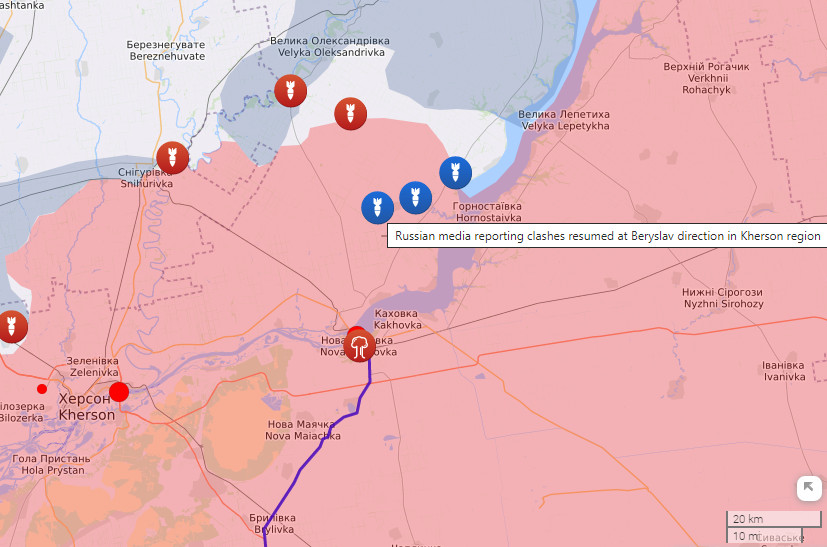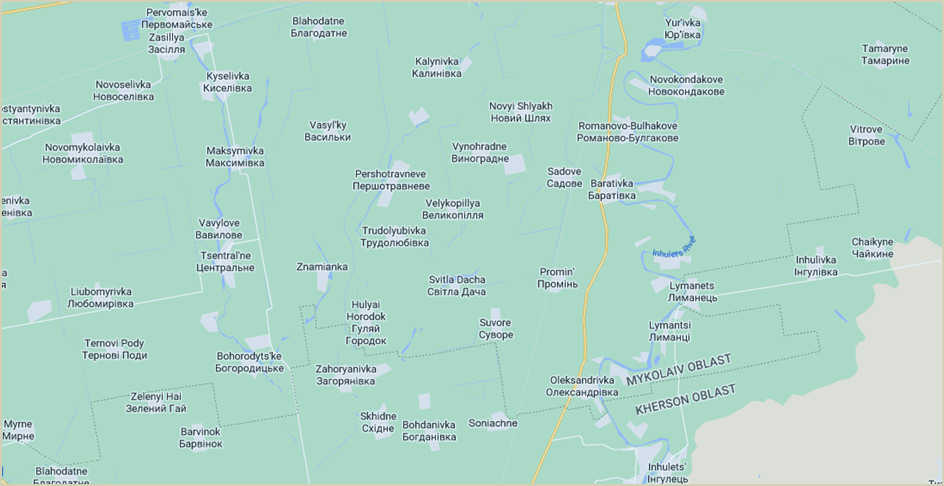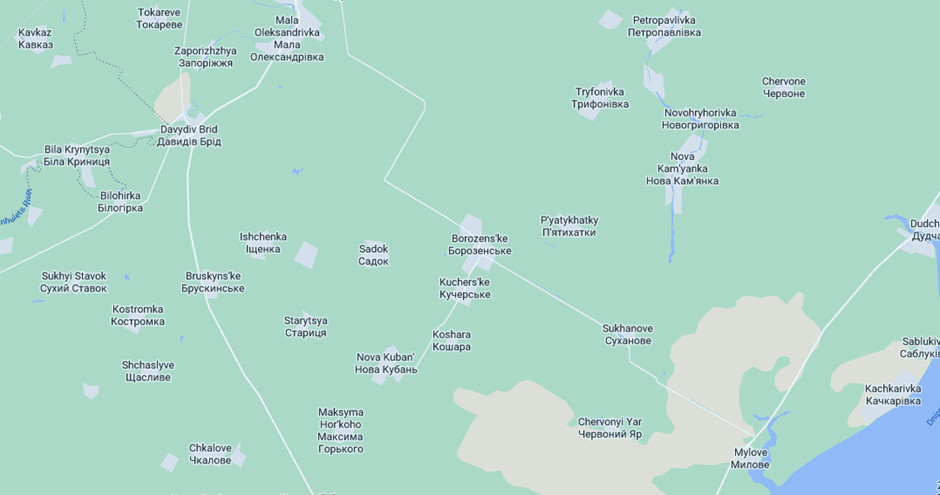The Zaporozhe “offensive” and for it the shaping of the battleground in Kherson (the “war on the fields”), according to propagandists for Ukraine
On Saturday 15th October the extraordinarily well-supported OSINT-mongering twaterati on social media reported to its huge audiences that a new manoeuvre by the armed forces of Ukraine was taking place in Kherson, resuming the earlier one that had been stopped on 2nd/3rd by the Russians at the inlet at Dudchany on the west bank of the Dnieper river.
Although it behoved the Russians in some areas now formerly of Ukraine to retire and let such Ukrainian manoeuvres come to them, and that the ability to cause much more damage when acting defensively† more than made up for the superficial appearance of loss of territory, it was pointed out at the time at this site that there would be a line drawn in the sand after which no more territory would be ceded.
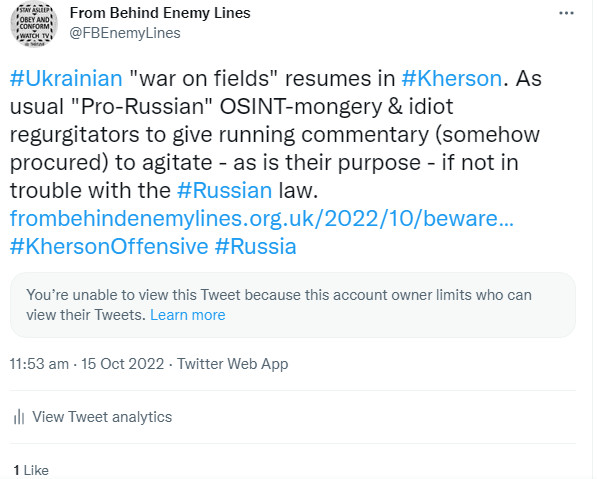
A retweet of a particularly detestable regurgitator (who is now blocking) by the author operating the FBEL twitter account. See footnote ‡
This moment appears to have arrived≠, because the new Ukrainian action was coming in the context of a very large assemblage of would-be attacking forces – 60,000 of them at different places across the entire front, according to the gossip of the abovementioned twaterati – and evidently all to no avail.
It has also been pointed out in the past at this site that the defining feature of the Russian Special Military Operation has two aspects. Firstly, there is always great damage inflicted upon the Ukrainian forces, disproportionately to that which the Russians allow to be done to themselves. Secondly, there is the issue of whether the Ukrainians are allowed to move, or are blocked. Despite what is suggested by the “blue map” (which is land said to be recovered from the Russians) that is sought by the anti-Russian axis for the sake of perception management, most of the time when the Ukrainians (and their NATO colleagues in the field) move towards Russian areas of control, the Russians have blocked, and this tendency has been reasserted this time.
The Russian MOD briefings since the 15th October give the details.
The enemy made unsuccessful attempts to launch an offensive towards Dudchany, Sadok and Ishchenka (Kherson region) at Nikolayev-Krivoy Rog direction.
Intense action of Russian forces have resulted in repelling all the attacks.
About 120 Ukrainian personnel, 17 armoured combat vehicles and 8 motor vehicles have been eliminated. Moreover, Russian artillery has destroyed 5 ferries installed by the AFU across Ingulets river.
[15th October]
Consulting Fig. 6, Sadok and Ishchenka are shown, as is Dudchany partially on the right edge. The overview in Fig. 5 informs that the first two settlements are completely within the Russian area of control (given that the line runs along the base of Nova Kam’yanka), as is the third – not just partly with a separation made at the inlet, but perhaps entirely by the sound of the briefing.
Up to 3 enemy battalions, including 1 armoured, made several attempts to break the defence of Russian troops near Koshara and Pyatikhatki (Kherson region) at Nikolayev-Krivoy Rog direction.
Russian units have maintained their positions and caused considerable casualties among enemy forces during fierce battles.
Over 250 Ukrainian personnel, 11 tanks, 14 armoured combat vehicles and 2 field artillery guns have been eliminated.
Russian troops have repelled the attacks launched by up to 1 mechanised infantry company per each towards Sadok (Kherson region), Zelyony Gai, Tamarino and Ternoviye Pody (Nikolayev region) at Andreyevka and Nikolayev directions.
Intense action of Russian troops supported by artillery has resulted in repelling all the attacks.
Up to 45 Ukrainian personnel, 4 armoured combat vehicles and 8 pickups with large-calibre machine guns have been eliminated.
Moreover, Russian unmanned aerial vehicles have destroyed 4 Zoopark artillery reconnaissance radars Zoopark and 1 U.S.-manufactured AN/TPQ-36 electronic warfare system.
Over 350 Ukrainian personnel, 11 tanks, 18 armoured combat vehicles, 8 special motor vehicles and 2 field artillery guns have been eliminated at Nikolayev-Krivoy Rog direction.
[16th October]
Again, Koshara and Pyatikhatki can be seen in Fig. 6. Zelenyi Hai, Tamaryne and Ternovi Pody can be found in Fig. 5, where only the left edge of the territory is not under Russian control.
Russian troops have prevented an attempt made by AFU units to break the defence near Bruskinskoye (Kherson region) at Nikolayev-Krivoy Rog direction.
Over 100 Ukrainian personnel, 13 armoured combat vehicles and 8 motor vehicles have been eliminated.
[17th October]
Bruskyns’ke is a settlement southwest of Ishchenka, to be seen in Fig. 6.
And with the Russian Ministry of Defence briefing of 17th October, one receives an overwhelming sense of the [current҂] grand Ukrainian operation in Kherson finally having had all the stuffing knocked out of it. Presuming the 16th October sample ends with a summary, the author makes Ukrainian losses out as 515 dead, with materiel losses of 11 tanks, 48 infantry fighting vehicles, and 24 other motor vehicles, over the course of three or four days.
Now, when this casualty list is compared with one that comes with the slow grind of the Russian offensive in Donetsk (see footnote), if one is wise, one might conclude that the party to this conflict looking to demilitarise the other has actively looked for such opportunity.
One doesn’t have to have served in any military of any country to be able to do some very basic reading and understand the extent of Russian capabilities, and especially how they were used to definitively and interminably shape the course of the conflict in the first few weeks, so as to know that a situation cannot exist in the Special Military Operation where there is powerlessness on the Russian part against the whim of the Ukrainians and their US/UK commanders. However, this is not what certain “authoritative” personalities of the spangling cosmos of alternative media geopolitical analysis have been telling their audiences – quite to the contrary, in fact.
As the reader may or may not know, authority in the alternative media comes from the size of an audience as it might be demonstrated in the number of YouTube subscriptions, for instance, or the number of comments under a textual piece. The truth rarely realised is that this “authority” is part and parcel of being set up, springing fully formed from the ground as is mostly the case, as controlled opposition. So, the circumstances are such that even though the author is demonstrably knowledgeable so that certain outcomes can be somewhat predictable, the material he produces is not “authoritative” information because he does not have any kind of audience that in any way could be called large. Moreover, because marginalisation goes hand in hand with not being “authoritative”, the author is, by design, practically alone on the internet in saying that the Ukrainians cannot move in any meaningful way unless the Russians allow it. Although this is demonstrated in reality, it is not “authoritative”. And, it goes without saying, it is acutely (discriminatively) marginal.
On the other side of the coin is a so-called Tony/Brian Cartalucci/Berletic, who is not known for having a font style named after him, although it sounds like he should be, but for being an ex-US Marine who surprisingly didn’t go into US intelligence but became an alternative media poster-boy journalist/analyst instead. On the 15th October, the said character published a video on The New Atlas channel on YouTube in which he referred to the liveuamap shown in Fig. 1, and told his now 125,868-strong audience (at the time of writing) the following:
Now, about Kherson. How serious is this situation in Kherson?… You can see they’re [the Ukrainians] pushing along the Dnipro river. Kherson is down here, so that’s quite a distance that they have to go. It’s hard to tell whether their final goal is Kherson, or maybe something a little bit closer, maybe they’re shaping the battlefield finally for the Zaporizhzhia offensive – hard to tell.
The primary objection to this utterance must be this: the mapmakers admit that their source is “Russian media”, and what is meant is the gossip by the twaterati – as this site has more than adequately demonstrated previously. But with Cartalucci/Berletic, there’s no questions asked about authenticity. Indeed, although the distance between the icons representing Ukrainian “attacks” and Kherson is acknowledged, the important information about their placement is also not refuted. These icons would have the Ukrainians advancing beyond the southern limits of the map in Fig. 6, when in truth, no such thing ever happened.
So, here is tacit approval by the Cartalucci/Berletic character of a graphic representation of supposed Russian powerlessness, which is then reinforced by an explicit verbal statement about the same – which constitutes the reason for a secondary objection. Everything is stated in terms of what Ukraine chooses to do: the Russians, therefore, are not a factor. So, a person looking at this presentation would get the impression that it’s only a matter of Ukrainian decision-making as to whether they occupy Kherson city, or whether they create a springboard for further territorial conquest elsewhere.
It doesn’t matter if the Cartalucci/Berletic character goes on to say that Russians will win back what is captured, or that the Ukrainians suffer disadvantageous losses in the course of what he insists on calling offensives (and this language is significant), because evidence can’t or won’t be offered for it at the same time. Without this support, there’s no apparent reality of any prospect of what is, in any case, mitigation.
On the other hand, what the audience does see is evidence for the prospect of the loss of Kherson city –which is one of the proposals made – by way of the lying liveuamap, which appears to show unchecked immediate Ukrainian progress, and following that a BBC report telling of civilian evacuation from Kherson (the region), again with no questions asked by the host, and more importantly, no context provided of any ongoing systematic plan for keeping Russian citizens safe and away from a battlefield.
Operationally – in terms of what is most important for the Cartalucci/Berletic character to convey – the intention is clearly to make an impression of a certain immediate inevitability, and to sow concern and even demoralisation. And it’s not surprising that the Cartalucci/Berletic character often refers his audience to Alexander Mercouris, who was spotted doing exactly the same thing (see here). Here, then, is evidence of a concerted campaign.
Even more damning is the assertion that a “Zaporizhzhia offensive” (using the spelling that Cartalucci/Berletic employs) is an option for Ukraine on the back of these latest manoeuvres, and indeed it is any option at all, because there is no evidence at all of such a thing.
Yes, indeed, there has been gossip by the twaterati, which even telegraphs detailed Ukrainian plans for the operation to the extent that any idiot with a telephone knows that “on September 16, a meeting was held in Zaporozhye with the command staff of the Dnipro group of troops to discuss attack plans” (Figs. 7 and 8 are representative of this information, and indeed are evidently intended to summarise it). As dumb as all this is, this is what the Cartalucci/Berletic character must have been using as grounds when, on 8th October, he told his (now 126,590-strong) audience:
There’s another one [Ukrainian offensive] that we keep hearing about both from Ukrainian and pro-Russian sources, one from Zaporizhzhia pushing toward Melitopol and the point of this is to cut the land bridge from Crimea to the rest of Russia… What Ukraine is trying to do is cut Crimea off from the rest of Russia, that’s what that is meant to do. It has not been launched yet, there appeared to be obvious preparations, everyone is just holding their breath waiting for the offensive to begin. And then we had this attack [on the Crimean bridge]… Ukraine has been talking about destroying the Crimean bridge since it was built and especially from February onward this is all they’ve talked about is blowing up the Crimean bridge.
Now destroying the Crimean bridge – now think about this – you cut off the land bridge between Kherson and Crimea and the rest of Russia, but what difference does that make, is it really fully severed if you still have the Crimean bridge delivering supplies, additional troops… have you truly severed these two regions if that bridge is still standing? And the answer is no, so the timing of this attack and the fact that everyone is waiting for the Zaporizhzhia front to see action, I think that says a lot, I think they’re definitely connected, and it’s just a matter of time now – imminent – the launching of the offensive in the Zaporizhzhia region toward Melitopol.
What is being done here is the promotion of an Ukrainian propaganda stunt (undoubtedly conceived and executed by the masters of the art, the UK armed forces) into a significant military operation so as to lend support to the concept of an “offensive” into Zaporozhe not only as being credible, but actually inevitable and, drawing too much significance from the truck bomb over the Kerch Strait, imminent.
It’s nonsense, proven by the fact that an “offensive” hasn’t happened. Moreover, if there was any reality to the Cartalucci/Berletic character’s proposal, an “offensive” into Zaporozhe should perhaps have been timed to coincide with the bombing for the latter to have maximum effect. It didn’t.
However, as we have already seen, nothing deters the victimisation of The New Atlas’ hopeless audience, as the new Kherson activity is declared to be preparation so that the attack can finally happen. Yes, this word has been emboldened and placed in italics to represent the emphasis given to it in speech by the Cartalucci/Berletic character as he once again offered a classification for the promised Ukrainian activity as, not possible, but certain.
It turns out, reader, that the delay is due to the Ukrainian planners trying to establish a position from which to launch a waterborne operation across the broad Dnipro river. This is, in effect, what the Cartalucci/Berletic character implies – and there’s no wonder to it, because it absolutely is in accord with updated Rybar maps in October where recovered land in Kherson is utilised as staging points across the water. Apparently, then, if one compares with the September version, longstanding invasion plans were thrown out and replaced with something to show off ownership of the west bank of the Dnipro – to the detriment of the ease of the proposed operation, because waterborne attacks are notoriously difficult and the Ukrainians have immense difficulty driving tanks along Kherson roads without them being put out of action by the Russians.
There’s nothing else to say but it is eminently clear that plans for a Zaporozhe “offensive” as distributed on the internet are not serious, and are propaganda. Moreover, the likes of the Cartalucci/Berletic character are not going to be stupid so that they don’t know this. On the contrary, it provides the foundation for their work – let’s not make any bones about it.
Be that as it may, one will find over again that with being “authoritative” comes the ability to wriggle to stave off a loss of credibility, with audience moronism being an enormous help to this end. A cursory glance at today’s offering by the Cartalucci/Berletic character indicates that he may be blaming the absence of his certain “offensive” on Ukrainian overextension, according to the video’s title. In the show-notes, there is also the statement “Ukrainian offensives are grinding to a halt”. Note in both cases, the Russians don’t have any hand in it, and the resultant impression one might have is that Ukraine has chosen to slow because of too much success. You see, reader, it isn’t an aberration that the alternative media big name “expertise” is wrong or accidently misleading when it is plying its particular bait-and-switch angles: instead, it’s a project intended for the purpose, and it is relentless.

Fig. 2: A map of the situation in Kherson, presented in a Russian Ministry of Defence briefing of 15th October, 2022
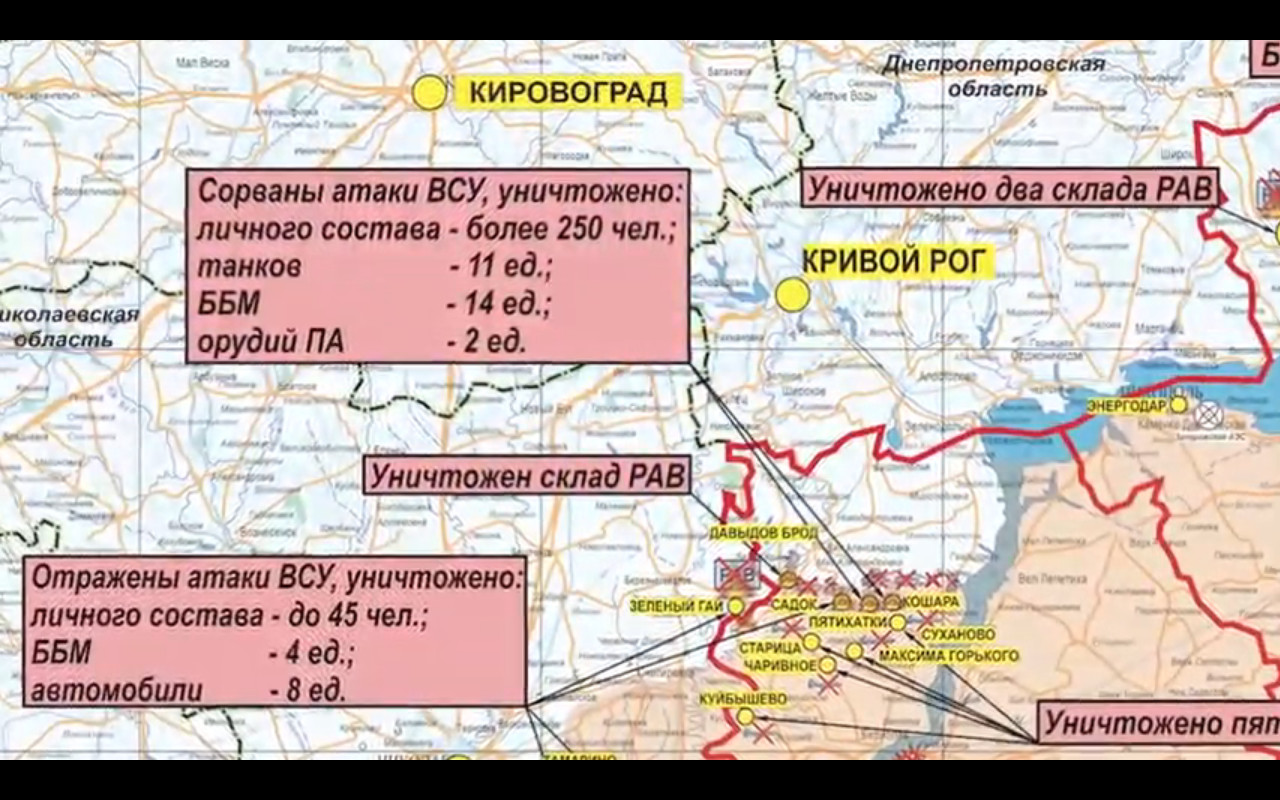
Fig. 3: A map of the situation in Kherson, presented in a Russian Ministry of Defence briefing of 16th October, 2022
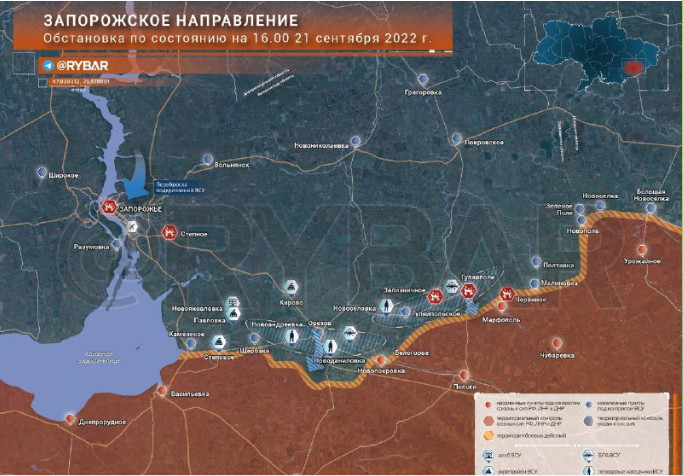
Fig. 7: Rybar apparently knows Ukrainian plans for a Zaporozhe “offensive” as they stand on 21st September
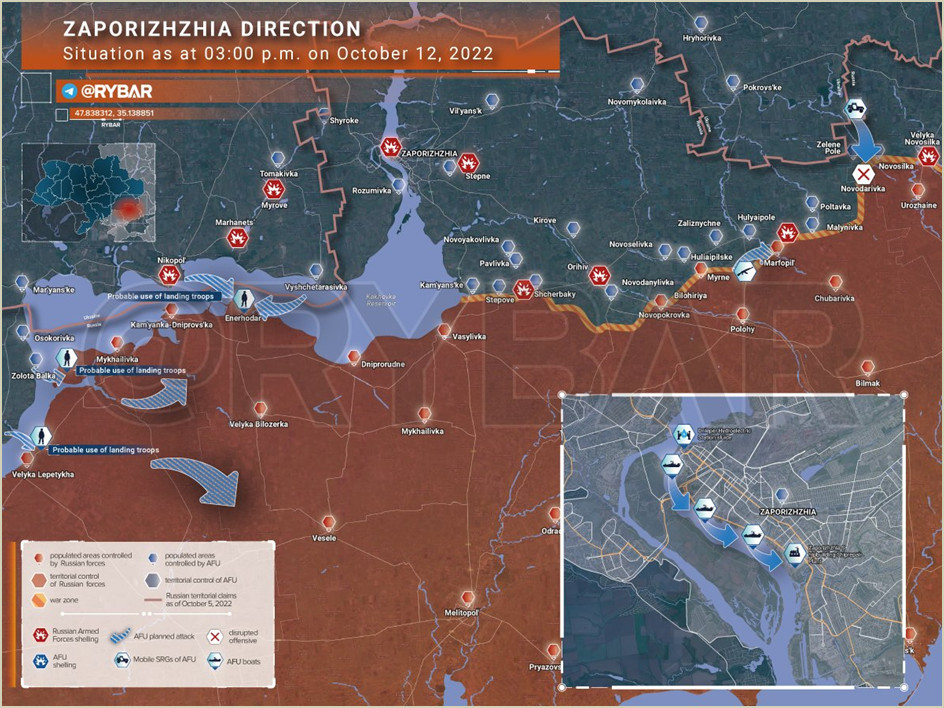
Fig. 8: Rybar have now received an update, and as of October 12th, the Zaporozhe “offensive” will include a ludicrous waterborne element.
† See Russian Gains And Ukrainian Losses In Donetsk, 1st September To 7th October (link) and note how a Russian offensive is more like a slow grind than a catastrophic flash in the pan.
҂ Qualification in brackets added 19:02, date as published. Of course, the gossip about the biggest Ukrainian “offensive” that you’ve ever seen never abates.
‡ The actual matter of the retweet: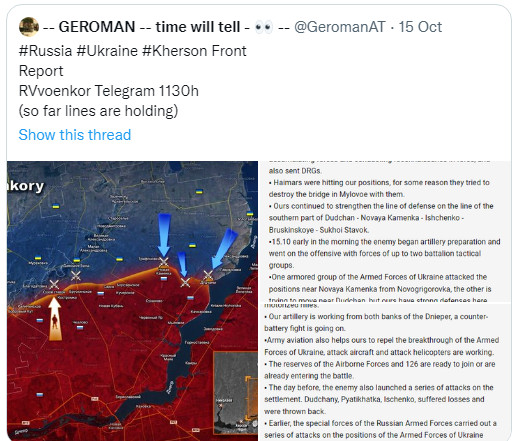
≠ Update, 20th October, 2022:
The Russian Ministry of Defence’s briefing for today offers evidence that the Russians’ line in the sand has indeed been laid down. The Russian MoD reports that the Ukrainians were ambushed at Sukhanovo/Sukhanove, so that there were “considerable casualties among enemy units”. In fact: “over 200 Ukrainian personnel, 14 tanks, 16 armoured fighting vehicles and seven motor vehicles”. Although this could be counted as being in the high side for one incident, it does not especially indicate a change so that the Russians are using artillery combined with their brigade level mobile counterparts in a counter-attacking defensive posture (as opposed to the mobile components being withdrawn or never present in the first place). What does perhaps indicate this is the capture of “three tanks, one infantry fighting vehicle and UR-77 mine action system” and 18 Ukrainian personnel. Obviously, the mobile components of Russian forces have to be to be present and at a place to absorb the Ukrainian forward movement in order to take these people and equipment into custody.




